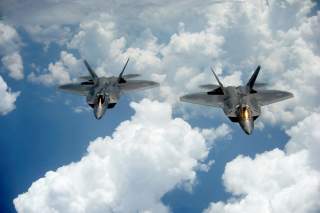America’s Dangerous Double Standard on Air and Sea “Provocations”
America needs to examine its own actions before it denounces those of rival powers. As matters now stand, Washington is guilty of hypocrisy, as well as provocative behavior regarding air and naval maneuvers.
The United States and its NATO allies are mightily agitated about the increase in Russian air and naval activity near the Baltic republics. According to NATO Secretary General Jens Stoltenberg, alliance warplanes have scrambled 400 times in 2014 in response to Russian military flights, an increase of 50 percent over 2013. Western officials repeatedly denounce Moscow’s maneuvers as dangerous and provocative.
Statements by U.S. and NATO leaders, along with Western media accounts, foster the impression that Russian ships and aircraft arrogantly penetrate the airspace and territorial waters of alliance members. But when pressed, officials concede that the vast majority of incidents do not involve such illegality. Stoltenberg stated that most of the flights “are close to NATO airspace,” but he admitted that there were “a very limited number of violations.”
Reading the fine print of other Western complaints reveals similarly misleading imagery. Baltic leaders express anger that a Russian warship entered Latvia’s exclusive economic zone, but it turns out that the location was still some nine nautical miles outside the country’s territorial waters. Latvia’s Ministry of Defense fumed that Russian warships had “approached” Latvian waters some fifty times in 2014 and had “come close” to Latvian airspace some 200 times. Yet the Ministry did not cite verifiable violations of its territorial waters or airspace.
The actual substance of other episodes likewise seems far less dramatic than the scare headlines that have become routine in the Western press. NATO F-16 jets intercepted a Russian Ilyushin transport plane over the Baltic Sea on November 12, after it “approached” Estonian and Lithuanian airspace. Similar incidents took place between NATO aircraft and Russian Su-27 fighter planes on November 15 and 17. Again, the Russian offense was that its aircraft were found “near Latvia’s territorial seas” in the former case and had “approached Estonian and Lithuanian airspace” in the latter. Despite such complaints, the encounters indisputably took place over international waters, Western governments acknowledged.
Calling the Russian actions provocative has some merit. Nations understandably become jittery when foreign ships and aircraft operate near their territory. That nervousness mounts when the foreign power has tense relations with one’s own country, and that is certainly the case, given the deterioration of relations between Russia and the NATO states in response to the Ukraine crisis. Adding to the tension is that Russian military planes are operating without activating their transponders, thereby increasing the hazard to commercial air traffic.
But one might at least expect the United States and its allies to be consistent about their attitude toward provocative air and naval maneuvers. Instead, the United States has adopted a blatant double standard when it comes to the actions of its own armed forces. China, for example, has asked that U.S. (as well as Japanese and South Korean) military aircraft respect Beijing’s air defense identification zone in the East China Sea and provide timely information about flights entering that area. Washington and its allies not only refuse to do so, they refuse even to recognize the legitimacy of that zone. Yet such resistance is not considered to be provocative or creating a threat to aircraft safety.
In addition, the United States routinely operates reconnaissance flights barely outside China’s territorial airspace, including near a major Chinese submarine base on Hainan Island. Those flights, and China’s dispatch of fighter planes to intercept them, have led to a number of nasty incidents, including a near collision earlier this year and an actual collision in 2001. Yet Washington has brushed off Beijing’s complaints, noting that the reconnaissance planes are operating in international airspace. Indeed, U.S. officials chastise China for trying to intercept and harass the spy flights.
All parties need to adopt a more prudent approach and recognize that what may be legitimate under international law is not necessarily wise. The United States has a legal right to send its spy planes near the Chinese coast to monitor sensitive Chinese military installations. And Russia has every legal right to operate military ships and planes in areas close to the boundaries of NATO member states. But such actions by both countries are also provocative and dangerous. As the 2001 U.S. incident with China confirmed, the risk of an accident or miscalculation is unacceptably high. That episode created a major crisis between Washington and Beijing. An incident involving Russian and NATO planes in the Baltic region could easily escalate, leading to a frightening military confrontation between the West and Moscow.
One would hope that all relevant governments would step back and seek ways to reduce the level of risk. In addition, the United States needs to examine its own actions before it smugly denounces those of rival powers. As matters now stand, Washington is guilty of hypocrisy, as well as provocative behavior regarding air and naval maneuvers.
Ted Galen Carpenter, a senior fellow at the Cato Institute and a contributing editor at The National Interest, is the author of nine books, the contributing editor of ten books, and the author of more than 600 articles and policy studies on international affairs.
Image: Flickr/Official U.S. Air Force/CC by-nc 2.0

